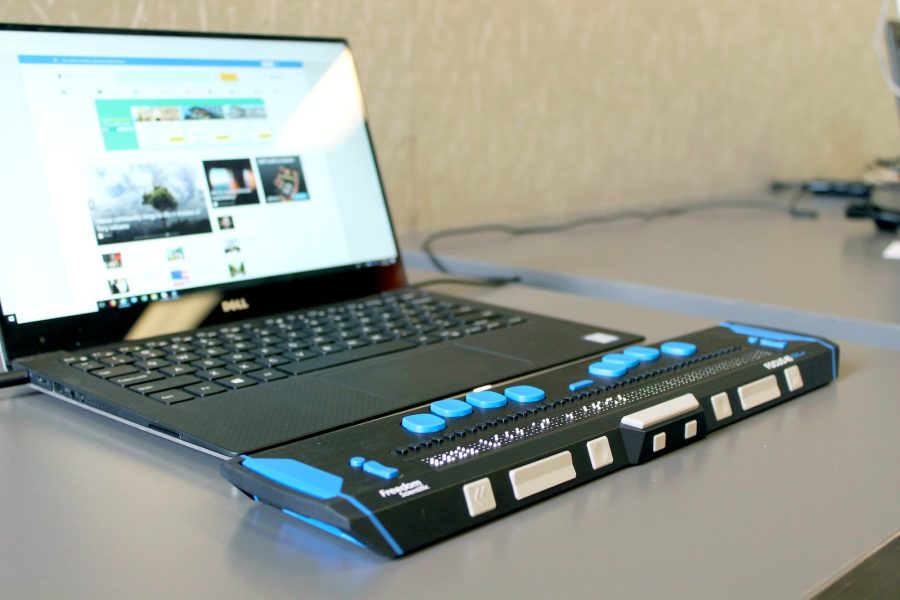The Royal Society for Blind Children which supports blind and partially sighted children, young people and their families across England and Wales is encouraging employers to provide more opportunities for workers who are visually impaired.
Last month, the charity hosted a free employment seminar, at the charity’s Life Without Limits Centre in London, by London Bridge, to highlight how the publicly funded Access to Work scheme operates and the technology available to support vision impaired people in the workplace.
- Only 1 in 4 registered blind and partially sighted people of working age are in employment in the UK.
- In London alone there are around 40,000 unemployed blind and partially sighted people of working age, the equivalent of 400 double-decker buses of wasted potential.
- 6 out 10 people in employment have never come across a blind person. Every day, four more children will be diagnosed with sight loss.
Sue Sharp, CEO of RSBC said,
Inclusion has a critical role in any organisation’s strategy and forms an important pillar in assessing companies’ ESG performance. Yet only 25% of those with sight loss are currently working.
Blind and partially sighted young people have aspirations and ambitions like anyone else. Together with those in the business community we can help them to realise their potential and lead a fulfilling life.
Sue Sharp, CEO of RSBC
Seema Flower, MD of Blind Ambition, attended the event and shares her insights and knowledge on how employers can support blind and visually impaired employees.
Assistive technology to support visually impaired or blind employees in the workplace
Assistive technology for blind people is a rapidly growing field. As technology advances, we now have access to an incredible range of devices, programs, and apps that can make life for the visually impaired much easier. This technology ranges from simple aids such as Braille text to more complex tools such as screen readers, OCR programs, and sensory substitution devices.
Here are some easy steps employers can implement which will help support visually impaired or blind employees and ultimately create a more inclusive workspace.
Mobile Phones
So simple, and yet not everyone has access to a mobile phone, so ensuring employees have a mobile opens up a whole new world as this is perhaps the most important assistive technology for many blind.
Apple and other manufacturers have built accessibility into their devices from the ground up. The processing power of mobile phones has advanced considerably allowing them to deliver a wealth of value for blind people. Apps like OCR, Be My eyes and Blindsquare allow all sorts of functionality to be opened to the user but shouldn’t overlook simpler features like a voice-commanded clock, to tell the time, timers, stopwatches, voice notes, news reports, and music all of which make life easier for blind people. These simple tasks provide a significant step towards independence for many.
Mobile Apps
Mobile apps have become an increasingly important aspect of assistive technology for all of us and especially blind people. There are now many apps designed specifically to assist blind people with daily tasks, enhance navigation, and improve accessibility.
Some popular apps include Be My Eyes, which uses a smartphone’s camera to read text and recognise objects; BlindSquare, which provides audio-based navigation for blind users; and Seeing AI, which uses artificial intelligence to provide audio descriptions of objects and people in real-time.
Apps such as Otter also assist visually impaired or blind colleagues by recording audio of meetings for example, then the notes are transcribed. This helps save time and money and these apps can help to improve the independence and quality of life for blind people, and many are available at no cost or for a low cost through app stores.
Screen Readers
Screen readers are software programs that read text on a computer screen aloud, making it possible for blind people to navigate and use computers. These programs can read every single element on a screen, including menus, text fields, and images. It’s also possible to adjust the reading speed and voice, making for a more personalised experience. Screen readers such as JAWS, NVDA, and VoiceOver are some of the most popular assistive tools used by blind people.
OCR Programs
Optical Character Recognition, or OCR, is a technology that enables blind people to read printed text without the need for a sighted person or a Braille edition. OCR programs use algorithms to analyse and interpret printed text, converting it into digital text that can be read out loud by a screen reader. OCR programs such as Abbyy Finereader, KNFB Reader, and Prizmo are incredibly useful in enabling a visually impaired person to read printed material.
Smart Speakers
In recent years we’ve seen an explosion of smart speaker devices for the home which can be linked to other devices around the home with the Internet of Things. This allows the blind user to do all the simple things like ask the time, for the latest headlines, to play their favourite music or an audiobook but it also allows the speaker to interact with other devices, such as turning the heating up or down via a connected thermostat or ordering items for delivery from Amazon. These are major steps forward, giving blind people more independence and control of their world.
Screen Readers
Screen readers are software programs that read out the text displayed on a computer, tablet, or smartphone screen. They use artificial voice technology to convert text into speech, enabling blind users to understand the content of websites, emails, documents, and other digital media.
Popular screen readers include NVDA (NonVisual Desktop Access), JAWS (Job Access With Speech), and VoiceOver. Some operating systems such as Windows and macOS also come with built-in screen readers, making them accessible to more users.
Magnification Software
Magnification software is used by people with low vision or partial sight to enlarge the text and images on a screen. The software typically comes with features such as colour contrast adjustment and screen tinting to make the content easier to distinguish.
Popular magnification software includes ZoomText, Magic, and SuperNova. In addition to software, there are also hardware magnification aids, such as handheld magnifiers and electronic magnifiers, which can provide greater flexibility and mobility for users.
Braille Displays
Braille displays are electronic devices that display text in braille format, enabling people with visual impairments to read more easily. They come in all shapes and sizes, from portable models for travel to larger systems for home use. Braille displays connect to a computer, tablet or smartphone, enabling the user to read braille that matches the text displayed on the screen. Popular braille display systems include Focus 40 Blue, Orbit Reader 20, and Refreshabraille.
Braille Embossers
Braille embossers are printing devices that produce paper output in braille format, enabling blind users to read physical documents. They work by converting electronic information, such as text files or PDFs, into braille dots that can be printed onto paper. Braille embossers vary in size and speed, with some capable of producing multiple pages per minute. Popular braille embossers include the Juliet Pro 60, Index Direct Braille 200, and the Braillo 600 SR.
Accessible Gaming
Gaming can be a fun and engaging activity for people of all ages, but for blind people, it can be challenging without assistive technology. Accessible gaming technology includes audio-based games, tactile gaming pads, and large-print game cards. One example is Audiogame, a website that provides a variety of accessible games for free. The games use sound cues and audio feedback for blind users to interact with and navigate the game.
Conclusion
Assistive technology has come a long way in providing greater accessibility and independence for blind people. From Braille displays to mobile apps, smart speakers to screen readers, there are now many options available to meet the unique needs and preferences of blind individuals. As technology continues to advance, there is a great opportunity to continue making strides in the field of assistive technology for visually impaired and blind people.
Seema Flower
Seema Flower was voted one of the 100 most influential disabled people in the UK 2020 according to the Shaw Trust Power 100 list. She is a driven and passionate advocate of equality. She has been training organisations in Disability Awareness issues for over 30 years. She is a qualified and experienced careers advisor. She has run her own Million-pound service business in Central London for 13 years and therefore understands the importance of balancing reasonable adjustments with business needs.



